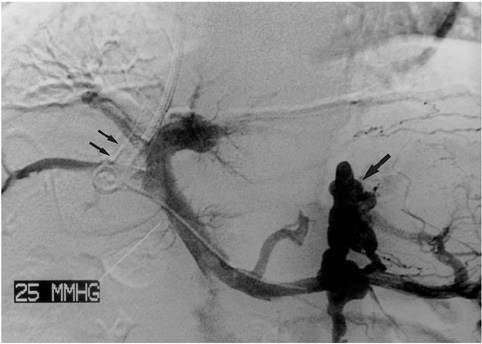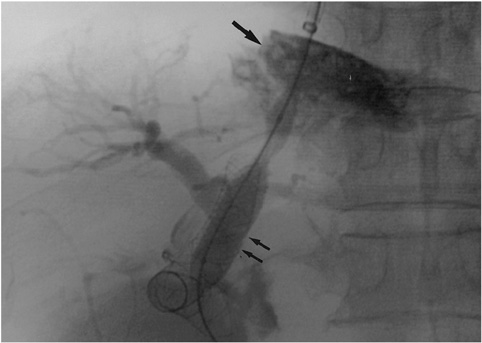Korean J Radiol.
2001 Dec;2(4):204-209. 10.3348/kjr.2001.2.4.204.
Transcaval TIPS in Patients with Failed Revision of Occluded Previous TIPS
- Affiliations
-
- 1Department of Radiology, Kyungpook National University School of Medicine. sck@knu.ac.kr
- KMID: 754089
- DOI: http://doi.org/10.3348/kjr.2001.2.4.204
Abstract
OBJECTIVE
To determine the feasibility of transcaval transjugular intrahepatic portosystemic shunt (TIPS) in patients with occluded previous TIPS. MATERIALS AND METHODS: Between February 1996 and December 2000 we performed five transcaval TIPS procedures in four patients with recurrent gastric cardiac variceal bleeding. All four had occluded TIPS, which was between the hepatic and portal vein. The interval between initial TIPS placement and revisional procedures with transcaval TIPS varied between three and 31 months; one patient underwent transcaval TIPS twice, with a 31-month interval. After revision of the occluded shunt failed, direct cavoportal puncture at the retrohepatic segment of the IVC was attempted. RESULTS: Transcaval TIPS placement was technically successful in all cases. In three, tractography revealed slight leakage of contrast materials into hepatic subcapsular or subdiaphragmatic pericaval space. There was no evidence of propagation of extravasated contrast materials through the retroperitoneal space or spillage into the peritoneal space. After the tract was dilated by a bare stent, no patient experienced trans-stent bleeding and no serious procedure-related complications occurred. After successful shunt creation, variceal bleeding ceased in all patients. CONCLUSION: Transcaval TIPS placement is an effective and safe alternative treatment in patients with occluded previous TIPS and no hepatic veins suitable for new TIPS.
MeSH Terms
-
Esophageal and Gastric Varices/*surgery
Feasibility Studies
Gastrointestinal Hemorrhage/*surgery
Human
Male
Middle Age
Portal Vein/radiography/*surgery
Portasystemic Shunt, Surgical/*methods
*Portasystemic Shunt, Transjugular Intrahepatic
Reoperation
Stents
Treatment Failure
Vascular Patency
Vena Cava, Inferior/radiography/*surgery
Figure
Reference
-
1. Zemel G, Katzen BT, Becker GJ, et al. Percutaneous transjugular portosystemic shunt. JAMA. 1991. 266:390–393.2. Sanyal AJ, Freedman AM, Shiffman ML, Purdum PP 3rd, Luketic VA, Cheatham AK. Portosystemic encephalopathy after transjugular intrahepatic portosystemic shunt: results of a prospective controlled study. Hepatology. 1994. 20:46–55.3. Somberg KA, Riegler JL, LaBerge JM, et al. Hepatic encephalopathy after transjugular intrahepatic portosystemic shunts: incidence and risk factors. Am J Gastroenterol. 1995. 90:549–555.4. LaBerge JM, Ring EJ, Gordon RL, et al. Creation of transjugular intrahepatic portosystemic shunt (TIPS) with the Wallstent endoprosthesis: results in 100 patients. Radiology. 1993. 187:413–420.5. Haskal ZJ, Pentecost MJ, Soulen MC, Shlansky-Goldberg RD, Baum RA, Cope C. Transjugular intrahepatic portosystemic shunt stenosis and revision: early and midterm results. AJR. 1994. 163:439–444.6. Coldwell D, Ring E, Rees C, et al. Multicenter investigation of the role of transjugular intrahepatic portosystemic shunts in the management of portal hypertension. Radiology. 1995. 196:335–340.7. Saxon RS, Ross PL, Mendel-Hartvig J, et al. Transjugular intrahepatic portosystemic shunt patency and the importance of stenosis location in the development of recurrent symptoms. Radiology. 1998. 207(3):683–693.8. Sterling KM, Darcy MD. Stenosis of transjugular intrahepatic portosystemic shunts: presentation and management. AJR. 1997. 168:239–244.9. Hausegger KA, Sternthal HM, Klein GE, Karaic R, Stauber R, Zenker G. Transjugular intrahepatic portosystemic shunt: angiographic follow-up and secondary interventions. Radiology. 1994. 191:177–181.10. LaBerge JM, Ferrell LD, Ring EJ, Gordon RL. Histopathologic study of stenotic and occluded transjugular intrahepatic portosystemic shunts. J Vasc Interv Radiol. 1993. 4:779–786.11. Saxon RR, Mendel-Hartvig J, Corless CL, et al. Bile duct injury as a major cause of stenosis and occlusion in TIPS: comparative histologic analysis in humans and swine. J Vasc Interv Radiol. 1996. 7:487–497.12. Saxon RR, Timmermans H, Uchida BT, et al. Stent grafts for revision of TIPS stenoses and occlusions: A clinical pilot study. J Vasc Interv Radiol. 1997. 8:539–548.13. Martin M, Zajko AB, Orons PD, et al. Transjugular intrahepatic portosystemic shunt in the management of variceal bleeding: indications and clinical results. Surgery. 1993. 114:719–726.14. Lind CD, Malisch TW, Chong WK, et al. Incidence of shunt occlusion or stenosis following transjugular intrahepatic portosystemic shunt placement. Gastroenterology. 1994. 106:1277–1283.15. Nazarian GK, Ferral H, Castaneda-Zuniga WR, et al. Development of stenoses in transjugular intrahepatic portosystemic shunts. Radiology. 1994. 192:231–234.16. Haskal ZJ, Duszak R, Further EE. Transjugular intrahepatic transcaval portosystemic shunt: the gun-sight approach. J Vasc Interv Radiol. 1996. 7:139–142.17. Rogopoulos A, Gavelli A, Sakai H, McNamara M, Huguet C. Transjugular intrahepatic portosystemic shunt for Budd-Chiari syndrome after failure of surgical shunting. Arch Surg. 1995. 130:227–228.18. Soares GM, Murphy TP. Transcaval TIPS: Indications and anatomic considerations. J Vasc Interv Radiol. 1999. 10:1233–1238.19. Chang RW, Shan-Quan S, Yen WW. An applied anatomical study of the retrohepatic segment of the inferior vena cava. J Anat. 1989. 164:41–47.20. Camargo AM, Teixeira GG, Ortale JR. Anatomy of the ostia venae hepaticae and the retrohepatic segment of the inferior vena cava, Part 1. J Anat. 1996. 188:59–64.21. McCowan TC, Hummel MM, Schmucker T, Goertzen TC, Culp WC, Habbe TG. Cardiac perforation and tamponade during transjugular intrahepatic portosystemic shunt placement. Cardiovasc Intervent Radiol. 2000. 23:298–311.
- Full Text Links
- Actions
-
Cited
- CITED
-
- Close
- Share
- Similar articles
-
- Transcaval Transjugular Intrahepatic Portosystemic Shunt: Preliminary Clinical Results
- Revision of Transjugular Intrahepatic Portosystemic Shunt (TIPS)
- A Case of Extrahepatic Portal Vein Thrombosis Treated by Transjugular Intrahepatic Portosystemic Shunt ( TIPS )
- Transjugular intrahepatic portosystemic shunts versus balloon-occluded retrograde transvenous obliteration for the management of gastric varices: Treatment algorithm according to clinical manifestations
- Pearls and Tips in Shoulder Arthroplasty





